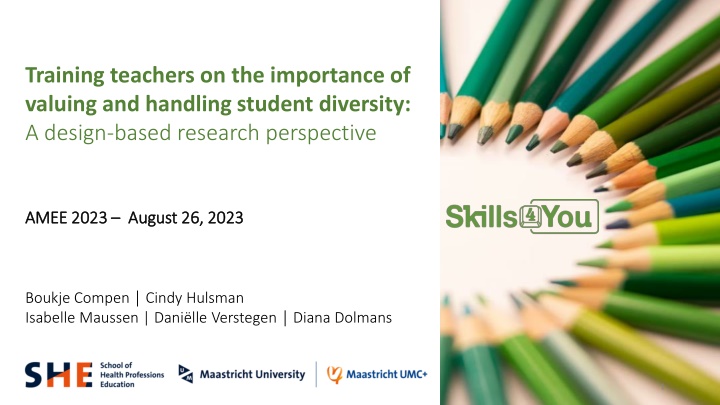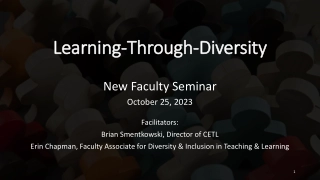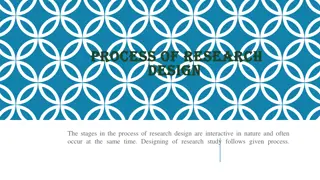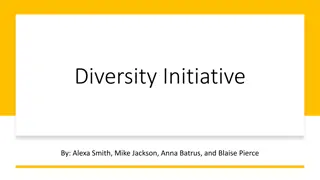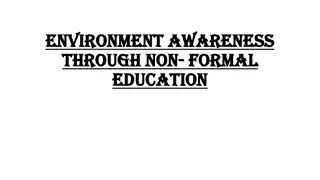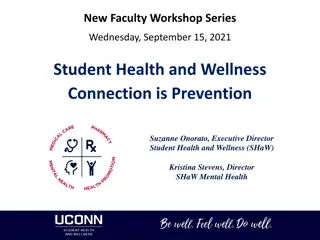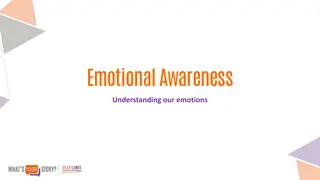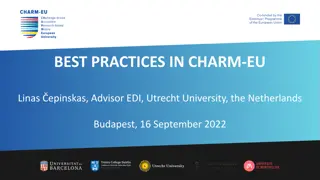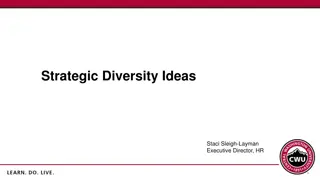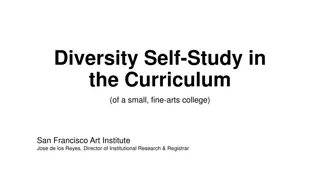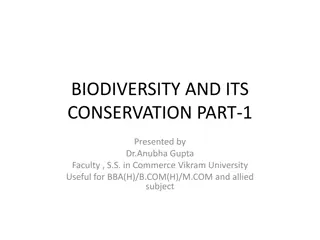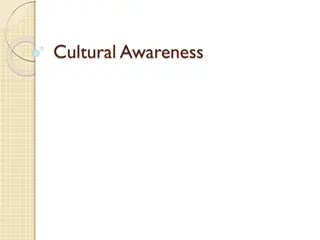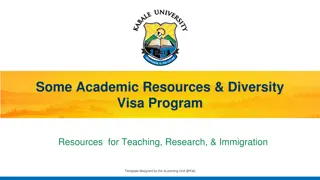Enhancing Student Diversity Awareness in Health Education: A Design-Based Research Approach
This research explores the importance of promoting student diversity awareness in health education programs. It emphasizes the challenges faced by educators in responding to individual learning needs and the necessity for faculty development. The study outlines principles for effectively addressing diversity and discusses the characteristics and phases of design-based research as a promising methodology. The focus is on improving practice and building on theory in real-life educational settings.
Download Presentation

Please find below an Image/Link to download the presentation.
The content on the website is provided AS IS for your information and personal use only. It may not be sold, licensed, or shared on other websites without obtaining consent from the author.If you encounter any issues during the download, it is possible that the publisher has removed the file from their server.
You are allowed to download the files provided on this website for personal or commercial use, subject to the condition that they are used lawfully. All files are the property of their respective owners.
The content on the website is provided AS IS for your information and personal use only. It may not be sold, licensed, or shared on other websites without obtaining consent from the author.
E N D
Presentation Transcript
Training teachers on the importance of valuing and handling student diversity: A design-based research perspective AMEE 2023 AMEE 2023 A August 26, 2023 ugust 26, 2023 Boukje Compen Cindy Hulsman Isabelle Maussen | Dani lle Verstegen Diana Dolmans 1
Background Student populations in secondary and higher vocational health programmes are increasingly diverse Educational systems worldwide are urged to Ensure inclusive and equitable quality education and promote lifelong learning opportunities for all (United Nations, 2015) >> >> This implies that health professions educators are more and more expected to adequately respond to students diverse learning needs United Nations, 2015 2
Background An investigation by the Dutch Inspectorate of Education in vocational education revealed that: Although teachers recognise the importance of responding to individual differences and learning needs, putting this into practice remains a challenge. >> >> Need for (more) faculty development Inspectie van het Onderwijs, 2021 3
Background Principles underlying effectively addressing student diversity: Principles underlying effectively addressing student diversity: Strong goal orientation Monitoring continuously Challenging students Adapting instruction and exercises Stimulating self-regulation Keuning et al. 2021 4
Design-Based Research Characteristics Characteristics Improving practice & building on theory Conducted in real-life settings Involvement of different stakeholders Mixed methods Is a particular intervention effective in a given context? And under which conditions? Dolmans & Tigelaar, 2012 5
Design-Based Research Phases Design & Construction Analysis & Exploration Implementation, Evaluation & Reflect McKenney & Reeves, 2019 6
Theory Analysis Content o Transferability of principles to vocational education according to different stakeholders Design & Construction & Exploration Implementation Evaluation & Reflection Design of training o Authentic learning o Collaborative learning o Reflective learning >> Basis for research question >> Basis for research question Dolmans, 2019; Keuning et al. 2021; Kolb, 2015; Van Merri nboer et al., 2002 7
Research question How could a training designed to encourage authentic, collaborative and reflective learning create awareness of the principles that are essential to address student diversity? 8
Structure of training Design Design & & Construction Construction Analysis Analysis & & Exploration Exploration Implementation, Implementation, Evaluation & Evaluation & Reflection Reflection Introduction Core Closing Explanation of theory student diversity Identification of teachers challenges 9
Structure of training Design Design & & Construction Construction Analysis Analysis & & Exploration Exploration Implementation, Implementation, Evaluation & Evaluation & Reflection Reflection Introduction Core Closing Interactive videos Group assignment >> >> 10
Structure of training Group assignment Interactive videos Discuss the following two questions: What are we already doing regarding this principle in our own practice? What can we do differently or additionally regarding this principle in our own practice? >> >> Authentic learning >> Collaborative and reflective learning 11
Structure of training Design Design & & Construction Construction Analysis Analysis & & Exploration Exploration Implementation, Implementation, Evaluation & Evaluation & Reflection Reflection Introduction Core Closing Individual reflection Formulation points of action 12
Implementation Design & Construction Analysis & Exploration Country Country Training Training s sessions essions Teachers Teachers Implementation, Evaluation & Reflection The Netherlands 10 145 Belgium 11 161 Total Total 21 21 306 306 13
Evaluation Design & Construction Analysis & Exploration Data collection Data collection Mixed methods Open-ended questionnaire Focus group interviews oSemi-structured o3 teacher teams 9 teachers Mixed methods Implementation, Evaluation & Reflection Data analysis Data analysis oDeductive and inductive >> Authentic, collaborative and reflective learning as sensitising concepts 14
Evaluation Design & Construction Analysis & Exploration Preliminary results Preliminary results Focus group interviews Focus group interviews Themes Implementation, Evaluation & Reflection Awareness of differences between students Changes in daily practice due to the training Importance of team effort 15
Awareness of differences So I do see the added value of [the training], but I now also see the among among students students more and more. And I am becoming a bit more Teacher 9 the differences differences aware of of them more aware them. And in the weeks after [the training], you also notice that you encounter situations that that you you recognise recognise, small situations in which you notice observing the differences among students that were discussed. Those are the moments where, afterwards, you think: Ah yes, we talked about this a few weeks ago . Teacher 2 situations differences 16
Changes in daily practice With padlets, on different levels. And with direct instructions. A ten-week digital lesson plan. For each day there is, so to speak, such an entire list so that they have both direct instruction instructionand and variety variety I did give them [the students] enormous autonomy direct autonomy Teacher 3 At first, I always gave the student a lot of responsibility. And what I have done in particular, was to monitor monitor much much more more throughout throughout [the period]. In my view, students did not do enough [while working on the assignment] - Teacher 6 17
Importance of team effort It is not an individual sport we are doing here, this is a team teamsport sport Teacher 3 We never take the time and effort. But now you are deliberately brainstorming [with you colleagues] - Teacher 4 18
Reflection Design & Construction Analysis & Exploration Conclusion Conclusion As a result of the training, teachers have become more aware of the types of differences that may exist among students and of the opportunities that exist to value and address these in their teaching practice The integration of authentic, collaborative and reflective learning in the design of the training through the interactive videos and group assignments seems to have contributed to this outcome Implementation, Evaluation & Reflection 19
Reflection Design & Construction Analysis & Exploration Further Further insights insights Addressing student differences in one s teaching remains complex. A number of conditions applying this practice emerged in this study: oLongitudinal training / coaching oShared team vision oInstitutional support conditions for effectively Implementation, Evaluation & Reflection 20
Contact information b.compen@maastrichtuniversity.nl c.hulsman@maastrichtuniversity.nl 21
References Dolmans, D. H. (2019). How theory and design-based research can mature PBL practice and research. Advances in health sciences education, 24(5), 879-891. Dolmans, D. H., & Tigelaar, D. (2012). Building bridges between theory and practice in medical education using a design-based research approach: AMEE Guide No. 60. Medical teacher, 34(1), 1-10. Inspectie van het Onderwijs. (2021). Themaonderzoek differenti ren in MBO. Ministerie van Onderwijs, Cultuur en Wetenschap. Keuning, T., & van Geel, M. (2021). Differentiated teaching with adaptive learning systems and teacher dashboards: the teacher still matters most. IEEE Transactions on Learning Technologies, 14(2), 201-210. Kolb, D. A. (2015). Experiential learning: Experience as the source of learning and development. FT press. McKenney, S., & Reeves, T. C. (2019). Conducting educational design research. Routledge. van Geel, M., Keuning, T., Fr rejean, J., Dolmans, D., van Merri nboer, J., & Visscher, A. J. (2019). Capturing the complexity of differentiated instruction. School effectiveness and school improvement, 30(1), 51-67. Van Merri nboer, J. J., Clark, R. E., & De Croock, M. B. (2002). Blueprints for complex learning: The 4C/ID-model. Educational technology research and development, 50(2), 39-61. 22
